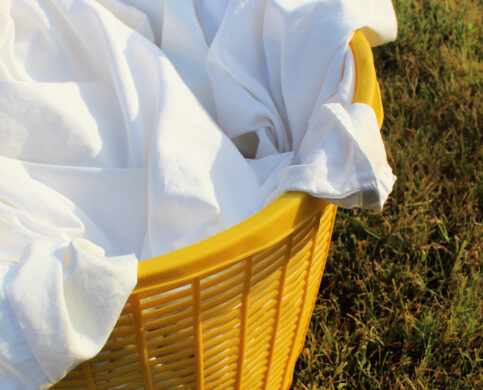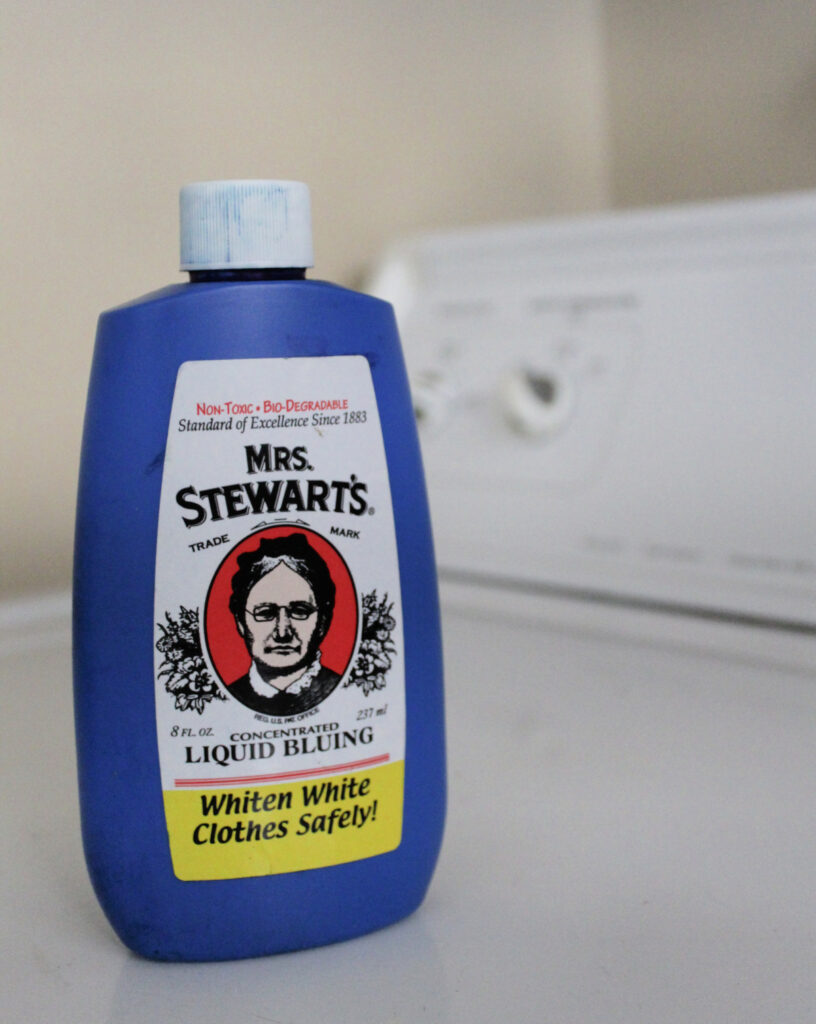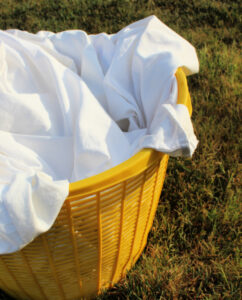
I have a way to help you naturally whiten laundry and restore it to that brand-new look of white laundry.
I love white linens. They look so clean and pretty on a bed or hanging from a towel hook. Because I do, I feel like I’ve intentionally made life harder for myself. Every little smudge shows.
This post may contain affiliate links. Read my disclosure policy here.
The problem with bleach
We’ve all been conditioned to associate the smell of bleach with “clean.” It certainly does a great job of cleaning and disinfecting and it whitens laundry well, but it comes with side effects. After consistent use, laundry can take on a yellowish look instead of white.
Some people experience negative physical reactions, some effects are temporary but others can linger. You can’t miss the warnings on the bottle either; it’s straight-up poison. You have to take precautions because it doesn’t mix well with many other products.
Its effectiveness also means that it’s harsh on the fibers in fabric. Your clothes and linens will wear out more quickly.
Finally, If you only use bleach every once in awhile, you’ll find that it’s probably not even a good value. Bleach will lose its effectiveness after about 6 months. If I open my bottle of bleach and it doesn’t even smell, I assume that it has also lost its bleaching power.
Bluing, an old way to whiten laundry
If you read any vintage books about homemaking, you’ll run across the mention of a product called bluing. It was essentially a concentrated blue dye that was added to white laundry to brighten it up. (Have you ever heard the term “blue-haired old lady”? It happened when hairdressers added a little too much bluing component to the hair rinse meant to brighten white hair.)
Clothing and linen manufacturers have long use bluing to ensure that brand new materials are beautifully white when you buy them.
Bluing used to come in a couple of forms. Back in the day there were balls and sheets of bluing, but there is one type of bluing that you can still easily buy, called Mrs. Stewarts.

How to Use Bluing to Naturally Whiten Laundry
It couldn’t get much easier. You just add a 1/4 t. to the wash water before you add in the laundry and that’s that. Your wash water should have a pale blue color.
Don’t add the blueing directly to clothes and make sure the bluing is dissolved in the water before adding the laundry. This is a dye, after all, and it can leave a blue stain. If you make sure to follow the directions, you’ll never have to worry that your white clothes will take on hints of blue.
Soaking plus Bluing
In a time when washers promise to do just about everything, there still isn’t much that can compare to a simple long soak.
I finally–finally!–figured out this trick that maximizes the effect of bluing. Is it necessary? No, but I like the added whiteness I get from an already great product.
The hint that I needed was from a couple of old books on homemaking. Housewives before the age of automatic washers soaked their laundry. A load of laundry didn’t take 40 minutes from start to finish or whatever washers do today. Homemakers would wash their laundry, rinse it, then let it soak in a separate tub of bluing water.
I combine the washing and the bluing steps. I add the bluing to the wash water along with the detergent. Add the laundry, let it agitate for a minute to be sure that everything is all mixed nicely, and that’s that. I like to give my laundry a soaking of at least 5 hours, but overnight would be my ideal. It just takes a little planning ahead.

You might want to take before and after pictures. Your white laundry will be a thing of beauty. And if you hang them outside on a clothesline? Even better! Don’t discount the bleaching effect that hours of sunshine will have on your white laundry, too.
Adding Bluing to a Front Loading Washer
You can easily add bluing to your wash even if you don’t have a top loading washer. Mix the bluing into a quart of water and pour it into the top along with the detergent.
Try it, you’ll like it! And another plus–the bottle doesn’t take up much space and lasts for years. You and Mrs. Stewart will be an item for a long time.
Discover more from A Housewife Writes
Subscribe to get the latest posts sent to your email.
2 Comments;
We’re SO glad you like our blog, Sarah!
That’s hilarious about the blue-tinged chicken feathers! I read that same tip about bluing relieving a bee sting, but I wondered if it’s worth sporting a dot of bluing on my skin?? Cheers to you, too.
What a great article! I just love your blog and I have been following along for a while now. The articles you find are fascinating.
I too am not a fan of bleach. Years ago my family and I used to show poultry at agricultural shows and poultry club shows. All the birds are washed the day before. Those chickens which were white or had a lot of white feathers were rinsed in an extremely weak blue solution. It sure made the white feathers really pop. It’s fairly easy to over do the blue and it wasn’t unusual for there to be white poultry with distinct blue tinges in the competitions They also looked pretty but unfortunately not what the judges wanted to see! In Australia our blueing product comes in a solid cube inside a cotton mesh bag. When slightly damp it can be pressed against a bee sting to relieve pain. Don’t know if that works as I’ve never needed to find out! Thankyou for a great blog. Cheers Sarah